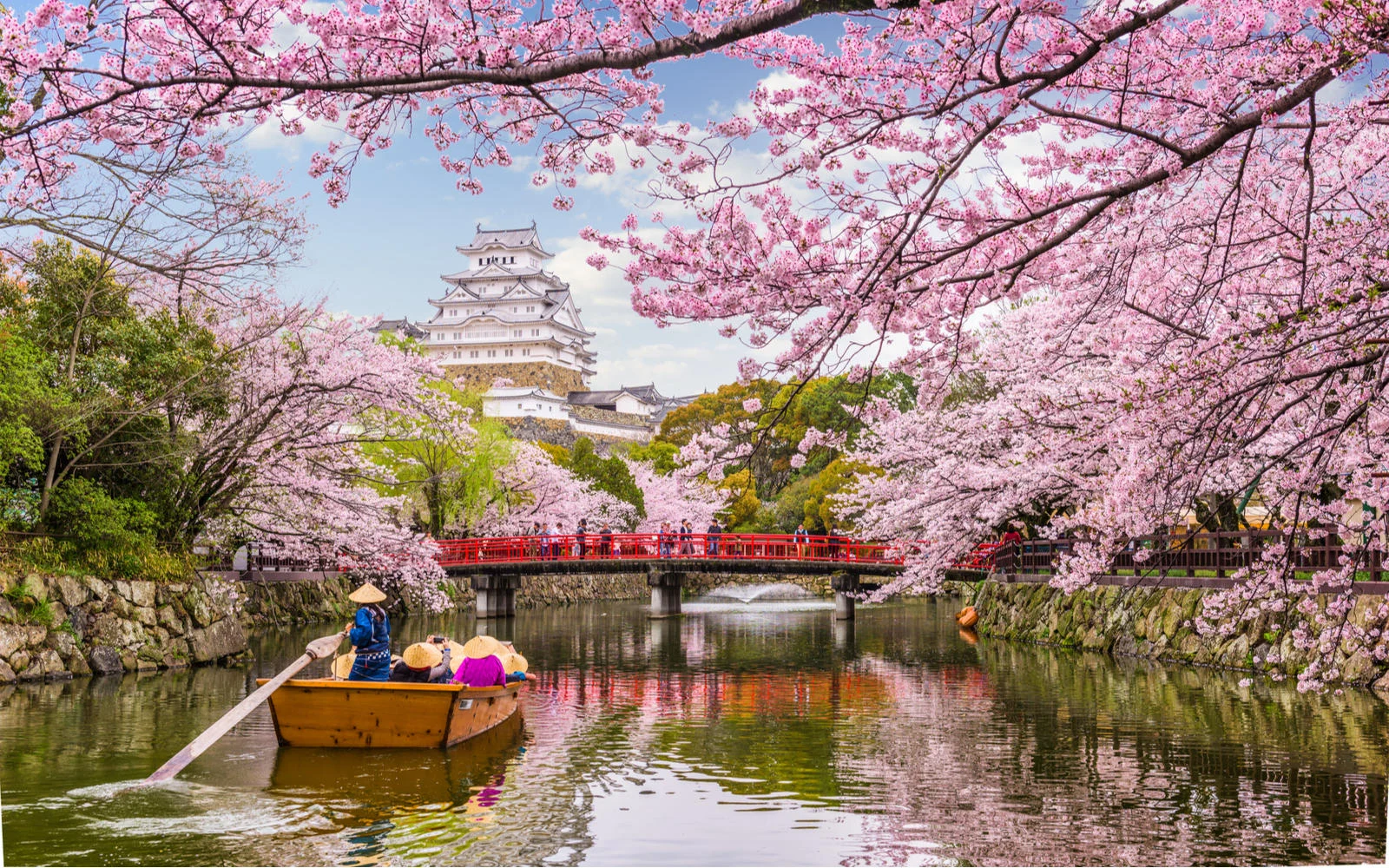What's the best time to visit Japan?
The best time to visit Japan is from March to May, the stunning cherry blossom season when the landscapes and mountains are washed in delicate pink and white blooms. This begins festival season, with colorful parades and processions to palaces, temples, and shrines taking place in Japanese cities. It’s the best time for sightseeing, outdoor activities, and exploring Japan’s history.
In Japan, the land of old and new, there’s so much to experience. From the Dubai-esque skylines of Tokyo and Osaka to temples lining cherry-blossomed streets of the ancient capital, Kyoto, the striking contrasts of this archipelago make it equally serene and exciting.
If you’re thinking about going, you’ll need to learn the best time to visit Japan to have the type of trip you’re dreaming of. Are you out for the best weather (or the famed sakura — cherry blossom — season)? Looking for the most affordable months? Hoping to avoid peak season crowds?
Maybe you can’t wait to get lost in Tokyo, wandering down noisy, neon-lit streets with food, shops, and markets vying for your attention or exploring its unexpectedly peaceful temples, shrines, and parks that whisk you away from the buzz of the modern world.
You might be planning to go to the rural villages of “old Japan,” where mountain views and charming wooden homes with thatched roofs surround you in Gokayama and Shirakawa. Maybe you’re excited to venture into Kyoto for its ancient palaces, castles, and quiet streets where the old ways are still practiced.
No matter what your plans for Japan may be, you’ll enjoy your stay even more when you know the right time of year to go. Below, we’ll share the overall best time to visit Japan, along with the cheapest, least busy, and worst months for a visit.
For each season, you’ll see ideas for things to do, average hotel and flight prices, weather conditions to plan for, and cultural festivals you’ll want to check out while you’re there.
Overall Best Time to Visit Japan
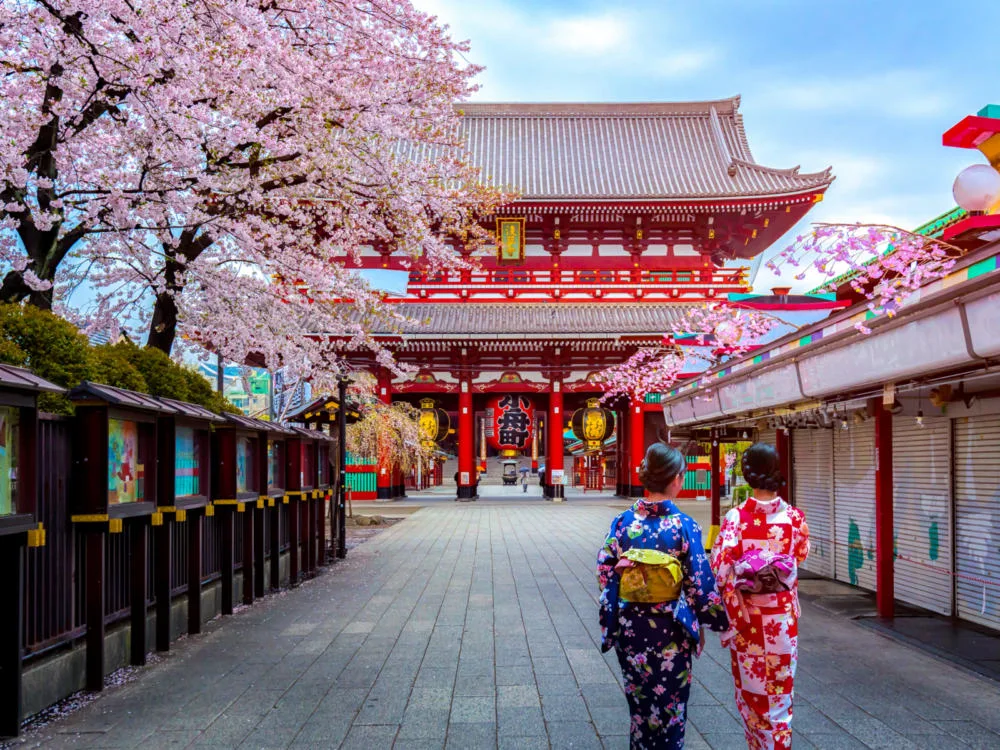
Phattana Stock/Shutterstock
The best time to visit Japan is March through May, when warm springtime temperatures, sakura blooms, and major festivals and cultural events make for great sightseeing and light the country up with life and color.
The climate in Japan tends to be mild and cool for most of the year with warm to hot summers, but you couldn’t ask for better weather than the balmy springtime. Rain is limited, sunshine is abundant, and temperatures hang between the upper 50s and mid-70s:
- March: 37–56°F; 7–10 rainy days
- April: 51–66°F; 7–10 rainy days
- May: 63–75°F; 8–11 rainy days
While peak travel season begins in April, arriving in March can help you avoid some of those crowds with cooler weather. Late March and April are when most of Japan experiences its famous sakura, or cherry blossom, season, compounding the magic of visiting this time of year.
Blooms can last well into May, so arriving just about anytime in the spring will give you the chance to attend vibrant cherry blossom festivals across Tokyo, Okinawa, and more. This time of year, Japan is turning lush and green, springing into colorful flowers, and alive with cultural festivals that draw hundreds of thousands to ornate temples and shrines.
It’s our favorite time to visit Japan and although crowds can be larger in April and May, the excellent weather and array of seasonal events in spring make it well worth it.
We’ve taken data from Google Hotels (2–5 star hotels) and Skyscanner (round trip flights from the U.S.) to show you what you can expect to pay to travel to Japan during these prime months of the year:
- March: $280/night; flights from $747
- April: $371/night; flights from $461
- May: $242/night; flights from $476
It’s important to carefully consider which month will be best for your visit. March is less crowded, but flights are more expensive; April sees higher hotel prices, but cheaper flights; May has more affordable hotels and flights, but may not give you the chance to see sakura blossoms in full bloom.
There’s a lot going on around the islands of Japan this time of year. Different regions and cities will offer varying experiences, depending on where you want to travel.
Come in late March and early April for a cherry blossom festival in Tokyo’s Ueno Park (the biggest in Japan), hike Mount Fuji for panoramic views and pink blooming phlox, attend festivals at shrines around Tokyo, Kyoto, and Komaki, and enjoy sightseeing with wonderful weather.
Some of the coolest places to visit in Japan during the spring are Kyoto’s Imperial Palace and its park, inundated with pink and white cherry blossoms, rainbow blooms at Hitachi Seaside Park in Hitachinaka, and illuminated blossoms at night in Takada Castle Site Park (Niigata).
This is the perfect time for hiking in Yamanakako Hanaomiyako Park for beautiful lake and Mount Fuji views with fields of flowers, celebrating national parks opening for the season in April with scenic Tateyama Kurobe Alpine Route hikes, or even skiing on Hokkaido in Niseko (March).
Vibrant Japanese festivals, or matsuri, take place year-round, but some of the biggest and best happen between these months:
- Hōnen (Mar) is a big harvest festival held at Komaki’s Tagata Shrine where locals make offerings in hopes of securing a bountiful harvest, alongside music, processions, and large traditional shrine floats
- Cherry Blossom Festivals (late Mar–early Apr) in all regions of Japan celebrates sakura season as it arrives with lanterns, food, illuminated trees at night, live music, and vendors in places like Tokyo, Okinawa, Matsue City, Tsuyama City, Joetsu City, and Hirosaki City
- Aoi (May) is one of 3 major annual festivals in Kyoto at the Shimogamo and Kamigamo shrines, drawing hundreds of thousands to the streets and shrines in historic Heian dress to process from the Imperial Palace to the shrines
- Kanda (May) in Tokyo is one of 3 major Shinto festivals, held at Kanda Myojin shrine with a mikoshi (portable shrine) parade that travels through neighborhoods with Heisei costumes, large floats, and samurai
- Sanja (May) is one of the major (and wildest) Shinto festivals in Tokyo at Asakusa Shrine where thousands congregate as mikoshi shrines are processed through the districts and finally brought into the shrine with music and traditional dancing
With some really affordable periods, some of the year’s best festivals, great weather, and the once-a-year event of flowery Japan exploding into bloom across the archipelago, spring is the absolute best time to visit overall.
Cheapest Time to Visit Japan
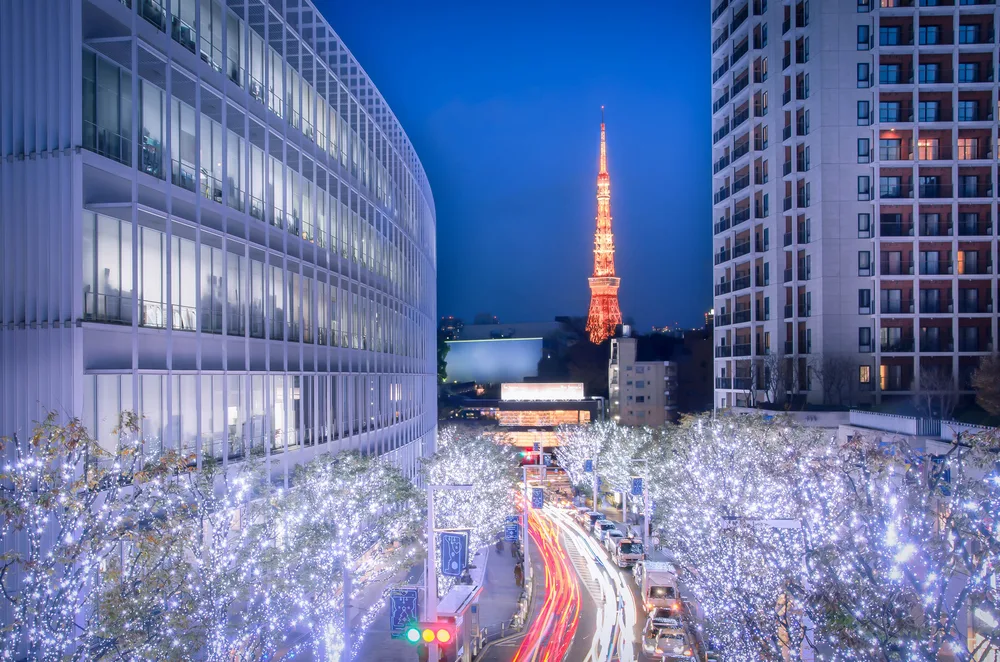
Wiennat M/Shutterstock
The cheapest time to visit Japan is between June and October. These warm-to-hot months can be wet (typhoon season), but the rain seems to deter some tourists and help keep prices down on flights and hotels.
This includes much of the May to October typhoon season across most of Japan, which usually peaks in August and September. The rainfall isn’t constant, however. You’ll have plenty of sunny days for sightseeing, temple and shrine visits, day trips to picturesque villages, and outdoor activities.
- June: 69–81°F; 7–13 rainy days
- July: 75–88°F; 9–13 rainy days
- August: 82–90°F; 10–12 rainy days
- September: 71–83°F; 11–12 rainy days
- October: 59–73°F; 9–12 rainy days
June through August can be very hot and humid across much of Japan, but Northern Japan is cooler year-round. Places like Furano, Hokkaido are experiencing spring-like weather with less rain and just-blooming flowers while vineyards explode in lush greenery.
If you’ll be visiting Tokyo, the hot summer months are best suited for exploring indoor attractions (and there are many). Check out the Buddhist Sensō-ji temple, enjoy views from the 2,080′ Tokyo SkyTree, and explore the shops and eateries along the famously packed and neon-lit Shibuya Center-gai.
Looking for sunny beach days with mountain views and endless water sports to try? Head to Okinawa Island’s capital city, Naha, where you’ll also find Shuri Castle and theme parks, or check out Ishigaki’s Maezato Beach ringed by green mountains and coral reefs.
By September, the daily highs turn around and start cooling down to the low 80s and low 70s by the time October rolls around. It’s like a second springtime (but warmer), making it a good time to enjoy outdoor activities like hiking, kayaking and canyoning in Minakami, and peeping fall foliage in full color in Kyoto and Nikko.
But the real reason for visiting Japan during the summer and fall is the more affordable travel costs during this time. Take a look at what we found in Google Hotels and Skyscanner data:
- June: $216/night; flights from $538
- July: $236/night; flights from $573
- August: $269/night; flights from $599
- September: $251/night; flights from $484
- October: $262/night; flights from $426
June is when you’ll find the cheapest rates on hotels across Japan, but prices aren’t bad in July, August, September, or October. October is notable during this budget-friendly season because you’ll find the lowest airfare from the U.S. during this time!
Just because this period is more affordable doesn’t mean Japan will be “dead” or less interesting. There are tons of cultural festivals and events happening between June and October, like:
- Sannō (Jun) at Tokyo’s Hie Shrine involves a special Shinkosai procession every other year with hundreds of people dressed in period clothing to carry mikoshi, lanterns, and enjoy traditional bon dance
- Atsuta (Jun) in Nagoya at the Atsuta-jingu Shrine brings traditional food from the region, dancing, artwork, and a massive fireworks display at this almost 2,000-year old shrine
- Gion (Jul) is one of the 3 major festivals in Kyoto, taking place in the city center and at the Yasaka Shrine with food, floats, parades, and music
- Nango Summer Jazz Festival (Jul) takes place in Aomori’s Hachinohe City in the bohemian Nango District with thousands of jazz musicians and bands playing free open-air concerts
- Sumidagawa Fireworks Festival (late Jul) in Tokyo lights up the skies with colorful displays around the Tokyo SkyTree in the largest fireworks festival of the year
- Tanabata/Star Festival (early Aug) celebrates the celestial union of mythical lovers separated by the Milky Way, borrowed from Chinese tradition
- Nebuta (early Aug) is Aomori’s biggest festival with colorful lantern floats (nebuta) covered in traditionally-painted washi paper and pulled through central Aomori by participants with costumed haneto dancers performing
- Asakusa Samba Festival (Aug/Sept) is Japan’s take on Brazilian Carnival with samba dancing contests as participants don flashy costumes
- Kishiwada Danjiri (Sept) in Osaka involves crowds pulling huge traditional wooden shrine floats through the streets
- Tokyo Ramen Festa (Oct) at Komazawa Olympic Park in Tokyo requires you to buy tickets to trade for ramen bowls at the event; find them at 7-Eleven around Tokyo or buy upon entry
- Jidai (late Oct) is the final of 3 annual major festivals in Kyoto, involving a large procession from the old Imperial Palace to the Heian Shrine with people in period dress, music, and food booths
It’s important to note that the typhoon season can spell disaster for outdoor plans when big, rain-heavy storms sweep through the country. Try to create some backup plans indoors if you’ll be visiting Japan during the cheapest months of the year, especially from August to October.
Least Busy Time to Visit Japan
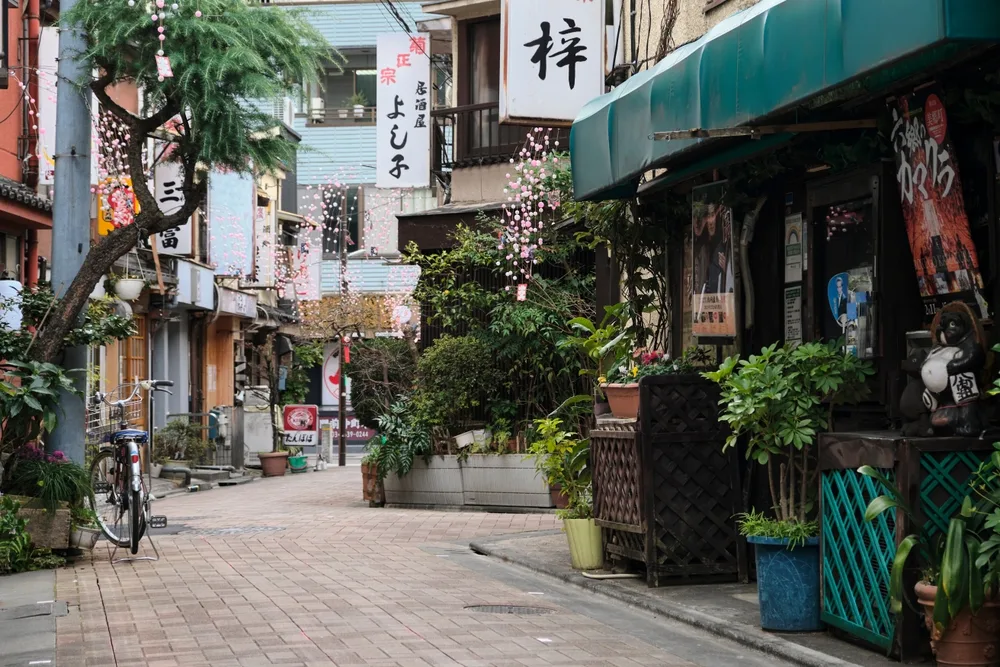
TOKYO, JAPAN – AUGUST 1, 2022: Traditional Street in Tokyo, Japan/Cavan-Images/Shutterstock
The least busy time to visit Japan is between May and June. These less-crowded months occur after Golden Week (late April to early May) and crowds die down as warmer weather, humidity, and heavier rainfall enter the forecast across Japan.
The temperatures you’ll experience during May and June vary by the location in Japan, but in general, you can expect highs from the low 60s to the low 80s across the country. May is a little drier and cooler than June, so it might be a better month to visit overall:
- May: 63–75°F; 8–11 rainy days
- June: 69–81°F; 7–13 rainy days
June may win out over May if you’re coming to enjoy some of Japan’s gorgeous subtropical beaches, plan on spending most of your time exploring indoor attractions in Tokyo, or will be visiting cooler islands and regions, like Hokkaido, posh Karuizawa, and Takayama City’s secluded Shinhotaka village.
Other than temperature and a slight difference in rainfall, May and June offer very similar conditions for a visit to Japan. They are both quiet months for a vacation, with each one seeing the fewest number of tourists you’ll find during the entire year.
That means some of the most popular destinations in Japan — like Imperial Tokyo, Hiroshima Peace Memorial Park, the historic center of Kyoto, Nara (Temple City), Nagoya’s Atsuta Shrine, and Osaka Castle — are perfect for a visit this time of year with smaller crowds.
May is slightly cheaper overall because you can find lower airfare to Japan this month, but June has the lowest average hotel prices of the year (sourced from Google Hotels):
- May: $242/night; flights from $476
- June: $216/night; flights from $538
Getting around Japan’s major cities, like Tokyo, Nagoya, and Osaka, is easy this time of year with the high speed rail, Tokaido Shinkansen. This rail connects you to surrounding cities and areas so you can expand your trip and enjoy the smaller crowds in multiple areas.
Aoi, Kanda, Sanja, Sannō, and Atsuta matsuris take place during May and June, so you won’t find any shortage of events to attend to see the old and new Japan brought together in colorful (albeit more crowded) celebrations.
Worst Time to Visit Japan
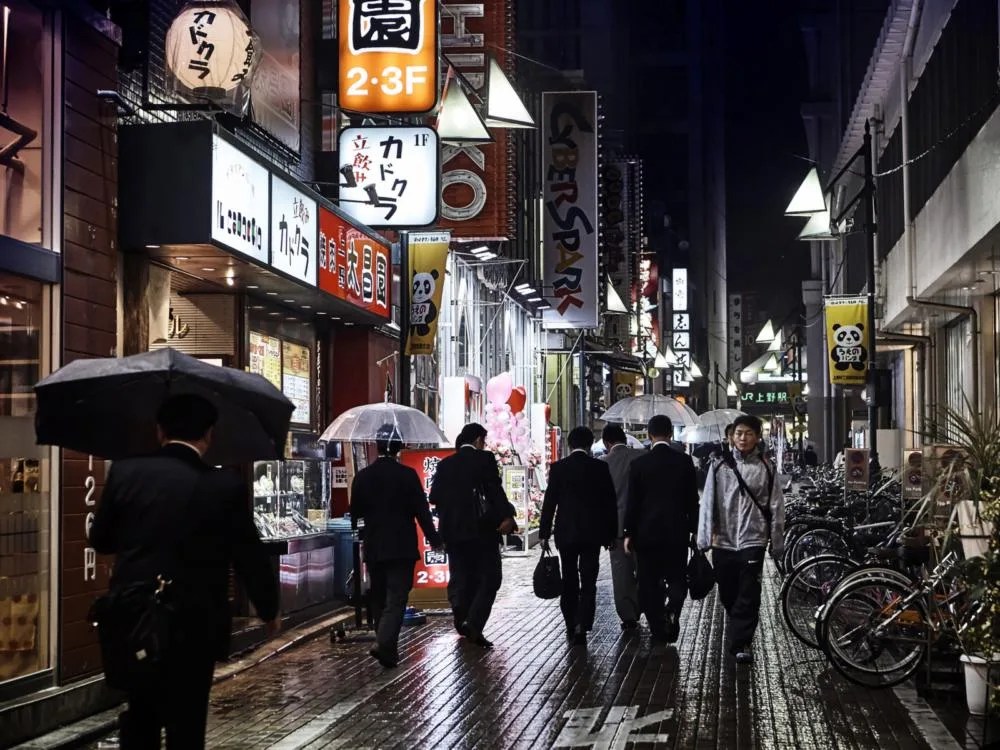
Liudmila Kotvitckaia/Shutterstock
The worst time to visit Japan is between August and September, the peak months of the typhoon season with hot, humid, and rainy weather. Conditions are not ideal during this time for sightseeing or outdoor recreation.
Rainfall happens for 10 to 12 days a month on average during August and September across Japan. While the rain can make spending time outdoors less enjoyable, it can be a welcome reprieve from the hot temperatures this time of year, sometimes reaching 90°F in Tokyo.
- August: 82–90°F; 10–12 rainy days
- September: 71–83°F; 11–12 rainy days
Historically, most of Japan’s major typhoons have occurred in August and September (including 6 in 2022 and 2023). That means one could occur while you’re here, hoping to enjoy the fall foliage that decorates Japan’s city parks and mountains with color.
When you visit parts of Japan during these fall months (like Tokyo and Osaka), the heat and humidity can feel almost miserable. Sticky, hot air makes strolling famous streets and parks less pleasant, but you will get to see some beautiful fall color this time of year (more so in September).
As far as prices go, it’s not a terribly expensive time to visit Japan, especially in September. Using averages taken from Google Hotels data and Skyscanner, you can see that August is a little pricier:
- August: $269/night; flights from $599
- September: $251/night; flights from $484
During the typhoon season, you could luck out with good weather for your trip — but it’s not a sure thing, and that’s what makes this the worst time of year to visit.
If skies do clear up, you’ll want to take advantage of the autumnal color with trips to Hokkaido’s mountainous Daisetsuzan National Park, Tokyo’s Rikugien Gardens among the ponds and plants, and Kyoto’s Eikando Temple, surrounded by blazing Japanese maples and gardens.
Explore Nikko (close to Tokyo) with its famous fall colors, visit Osaka Castle to admire its traditional architecture, take the 25-minute scenic Sagano Romantic Train through Arashiyama district of Kyoto, or the amazingly still Blue Pond in Hokkaido (where it’s a little cooler).
We’ve listed some of the annual festivals and events that happen during August and September above under Cheapest Time to Visit, but here’s a recap:
- Tanabata (early Aug) or the Star Festival is celebrated in July or August across Japan, with celebrations centering on Chinese traditions related to the Milky Way and stars
- Nebuta (early Aug) brings big colorful lanterns decorated with washi, or hand-painted paper, to the streets as participants carry them alongside traditional dancers
- Asakusa Samba Festival (Aug/Sept) is a miniature Japanese version of Brazil’s Carnival as dancers compete in the streets with colorful costumes
- Kishiwada Danjiri (Sept) sees huge wooden shrines (mishoki) to the streets in processions through Osaka as men pull the floats as fast as they can
While typhoons, rainfall, heat, and humidity make this period our least favorite to visit Japan, it can offer some bonuses for adventurous travelers — affordable prices, great autumn color, and periods with milder weather in September.
Japan by Month: What to Expect
Japan is a year-round destination, but it can be really incredible during certain months of the year. Take a look at what you can expect in Japan by month below to start planning your travel dates!
January
With a wide range of daily high temperatures from 28°F to 49°F this month (colder in the north), Japan’s winter weather can be freezing cold to mildly cool. With anywhere from 4 to 11 rainy/snowy days, this is a good time to go skiing in the Japanese Alps. Hotels cost around $202/night on average and flights are expensive, starting around $750 round trip.
February
February warms up with highs 30°F to 50°F, but it’s still winter and northern Japan is still getting snow. Tokyo and cities further south are mild and pleasant for exploring and sightseeing. Hotels are around $224/night on average and flights are cheaper than January. Check out the Sapporo Snow Festival, Lake Towada Snow Festival, and Hadaka festivals this month.
March
March is when spring weather triumphs in Japan, bringing daily highs from 37°F to 56°F with 7–10 rainy days. Sakura blossoms show up at the end of the month, cherry blossom festivals ring out everywhere, and hotels cost around $280/night on average. Flights are expensive, starting around $750 round trip. Check out the Hōnen harvest festival in Komaki’s Tagata Shrine this month.
April
April is an idyllic month to visit Japan with sunny skies for the most part and highs between 51°F and 66°F. With a week or so of rainy days throughout the month, you’ll find the best opportunities this month to check out temples in Kyoto, explore Tokyo’s eateries, parks, and markets, and enjoy sakura blossoms in full bloom with lots of cultural festivals.
May
Another perfect month to visit Japan, May sees highs between 63°F and 75°F with 8 to 11 days of rain. Hotels and flights are more affordable around $242/night on average and $476+ for round trip airfare. Special festivals, like Aoi, Kanda, and Sanja matsuris happen this month with colorful parades and shrine processions.
June
June is the start of summer and part of the wet, hot, stormy typhoon season with highs from 69–81°F and up to 13 rainy days. It’s one of the cheapest months to visit with hotels around $216/night on average, but flights are higher at $538 and up (round trip). Festivals like Sannō at Tokyo’s Hie Shrine and Atsuta in Nagoya’s Atsuta Shrine are popular events this month.
July
In hot and humid July, the typhoon season continues and brings 9 to 13 days of rain to Japan. Temperatures go up to 88°F in parts of the country, while major events like Gion (Kyoto), Nango Summer Jazz Festival (Hachinohe City), and Sumidagawa Fireworks Festival (Tokyo) happen. Hotels are around $236/night (great price) and flights start around $573.
August
Come August, prices are still pretty low for Japan with average hotel rates at $269/night and flights starting at $599 round trip. With highs up to 90°F and up to 12 rainy days, it’s peak typhoon season when more storms develop. Check out festivals like the Star Festival (celebrated country-wide) early this month and the massive Nebuta (Aomori) lantern float parade.
September
With highs dropping to 71–83°F this month and up to 12 rainy days, conditions are more tolerable (but stormy, as peak typhoon season) and still affordable. Expect to spend around $251/night on your hotel and upwards of $484 for a round trip flight. This month, you could see fall foliage, go to the Asakusa Samba Festival in Tokyo, or see Kishiwada Danjiri parades in Osaka.
October
October offers even more fall foliage with cooler highs from 59–73°F, but typhoon season is finally on its way out. Rainfall is still 9 to 12 days this month, but with some of the cheapest hotel and flight prices ($262/night and $426+ round trip), it can be a good time to visit. Check out the Tokyo Ramen Festa and the huge Jidai matsuri in Kyoto this month.
November
November is when Japan finally feels like fall across the board with highs from 45°F to 62°F and up to 13 rainy days. With events like the Tokyo International Film Festival and the Meiji Shrine Autumn Grand Festival, there’s plenty to do and see. Hotels cost around $265/night with expensive flights starting at $750 round trip.
December
As winter arrives in Japan, highs range from 33°F to 53°F and northern Japan experiences snow. Tokyo’s gardens and parks are draped in winter lights for an enchanting glow, and rainfall slows to just 4–9 days a month. With hotels around $244/night and flights starting at $776 round trip, it’s not a cheap time to visit.
Frequently Asked Questions
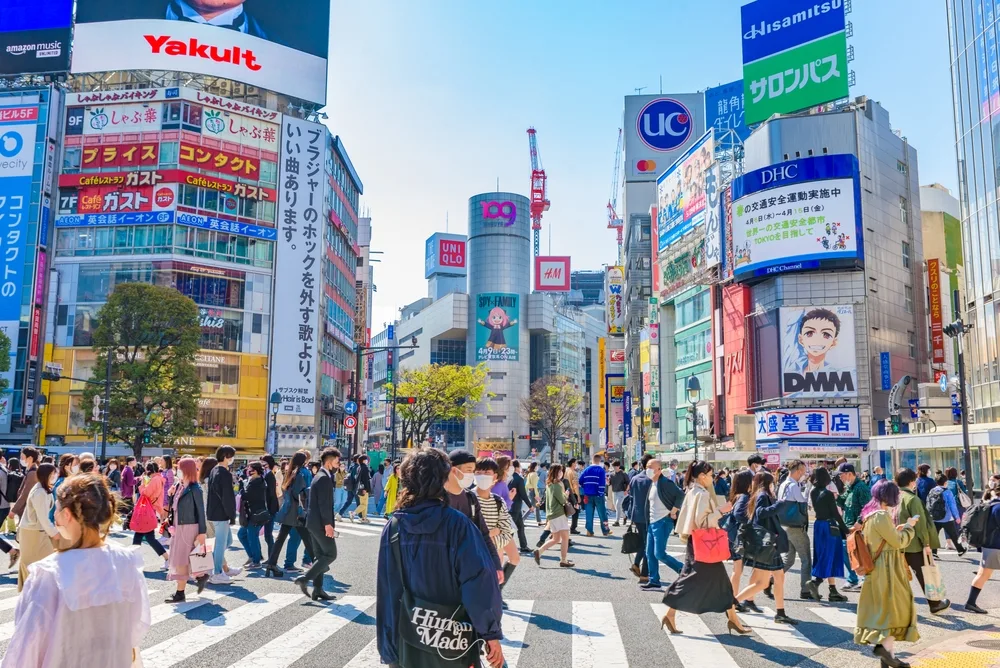
TOKYO, JAPAN – APR 8, 2022: View of Shibuya Crossing, one of the busiest crosswalks in the world/Takashi Images/Shutterstock
Think you’re almost ready to book your trip to Japan? Take a look at the most frequently asked questions from travelers below to learn more before you make it official.
What is the cheapest month to travel to Japan?
The cheapest month to travel to Japan is October, when you’ll find the lowest airfare and round trip flights start as low as $426 from the U.S. June is the cheapest month to stay in a hotel in Japan, with average nightly rates dropping to just $216/night, according to data from Google Hotels.
What time of year does Japan have the best weather?
Japan has the best weather in the springtime, from March to May. Expect mostly sunny weather with balmy highs ranging from 37°F up north in March to 75°F in Tokyo and southern cities in May. This 3-month period experiences around 7-10 rainy days on average and by April, highs don’t drop below 51°F.
What month is Japan most expensive?
The months of wintry December and peak season April are generally the most expensive in Japan. December sees the highest flight prices, with round trip flights from the U.S. starting around $776, and April has the highest average hotel prices at around $371/night, according to Google Hotels data.
How many days do you need in Japan?
You need 7-10 days in Japan if you want to experience one city in depth or explore more than one city with a little time to spend in different regions and islands. For a basic itinerary, you can see Tokyo, Kyoto, Nara, and Mount Fuji in 7-10 days.
Do U.S. citizens need a visa for Japan?
U.S. citizens do not need a visa to visit Japan for 90 days or less. You will need to have a valid passport to enter Japan and show your return ticket with a date no later than 90 days after your entry to enter the country visa-free.
So, What’s the Best Time to Visit Japan?
| 👍 Best Time to Visit | March-May |
| 💲 Cheapest Time to Visit | June-October |
| 🗓️ Least Busy Time to Visit | May-June |
| 👎 Worst Time to Visit | August-September |
The best time to visit Japan is between March and May, which encompasses the mild and colorful spring season when the famous sakura (cherry blossoms) are at their peak with limited rain, lots of sunshine, and nonstop festivals taking place.
June through October is the cheapest time to visit Japan, with rock-bottom hotel (June) and flight (October) prices that make your travels more affordable. In May and June, you’ll find the least busy time to visit Japan with smaller crowds.
We caution you against visiting in August or September, though, because they’re the peak months of the typhoon season and feature hot, humid weather with lots of rain.
With a long and storied past that’s evident in the cultural festivals, design, and presence of ancient temples, palaces, and shrines of its major and historic cities, this Asian archipelago is fascinating to visit — especially when you know the best time to visit Japan.



